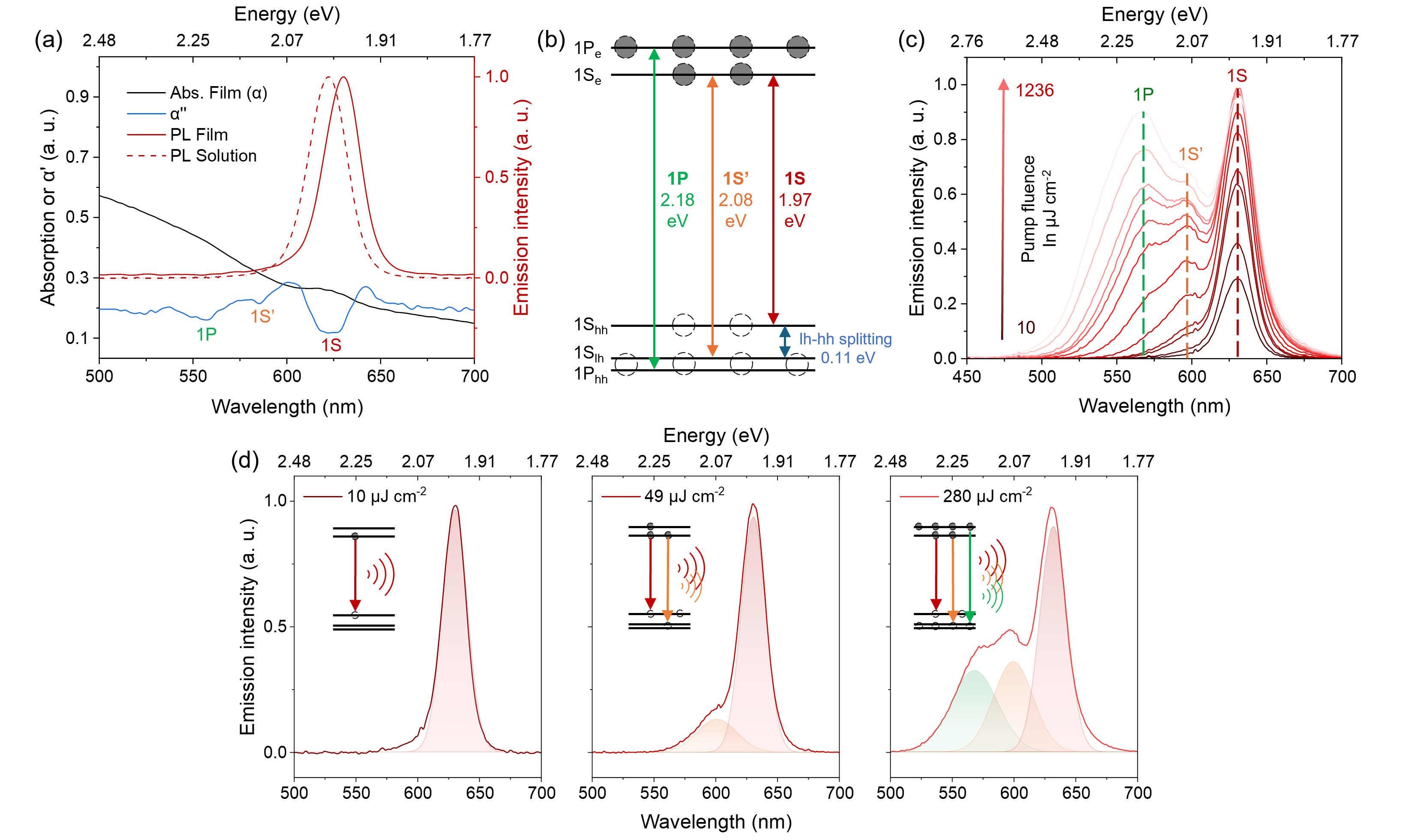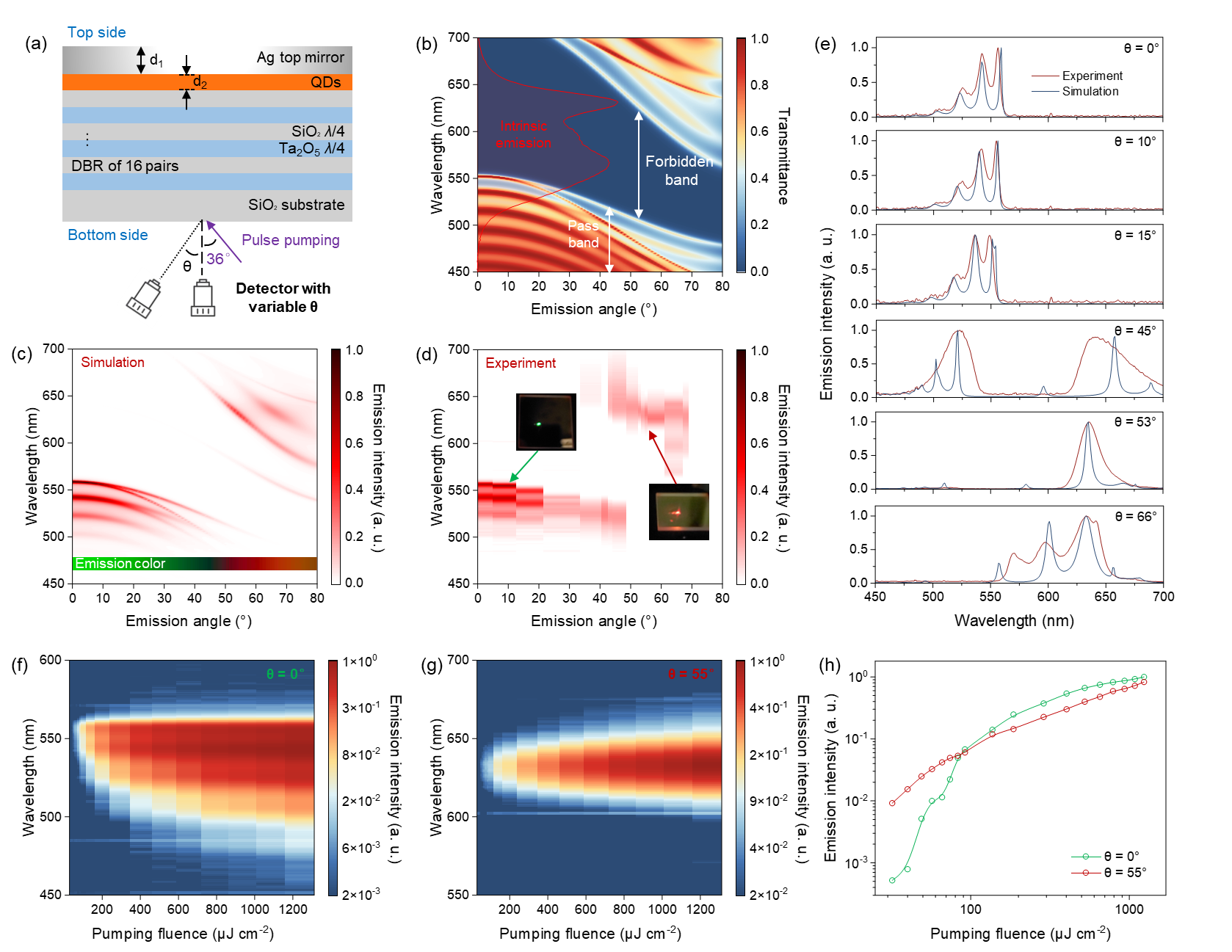Colloidal quantum dots (QDs) are semiconductor nanocrystals that have garnered extensive attention from both the academic and industrial communities in recent years. This is owing to their excellent and widely tunable optoelectronic properties, as well as their high compatibility with low-cost solution-based synthetic and processing techniques. The 2023 Nobel Prize in Chemistry was awarded to the three inventors of QDs—Moungi G. Bawendi, Louis E. Brus, and Alexei I. Ekimov—underscoring the significant impact of QD technology on the development of science and technology.

A collaborative team led by Professor Kai Wang from the Department of Electronic and Electrical Engineering at the Southern University of Science and Technology (SUSTech) and Professor Hoi Wai Choi from The University of Hong Kong (HKU) has successfully achieved low-threshold excitation of multi-excitonic states and anisotropic polychromatic emission from monodisperse QDs by coupling them with a microcavity exhibiting strong Purcell effect. Moreover, they demonstrated a full-color micro-pixel array based on monodisperse QDs.
This work presents a novel approach to modulating the multi-excitonic characteristics of QDs using microcavity, providing new insights into addressing the challenges of high excitation thresholds, broad spectral linewidths, and patterning difficulties associated with multi-excitonic emission from QDs.
Their related work has been published in National Science Review with the title “Low-threshold anisotropic polychromatic emission from monodisperse quantum-dots”.
QDs are typically smaller than or close to their exciton Bohr radius, which restricts how excitons move. This creates a unique “quantum confinement” effect, where the energy levels of the QDs resemble the discrete energy levels of atoms. The bandgap in QDs can be adjusted by tuning their composition, size, and/or structure to meet the requirements of various applications. Once produced, their optical properties tend to remain stable.
The researchers utilized QDs made of cadmium selenide (CdSe), which had an average particle size of 12.6 nanometers (nm). When these QDs formed a thin film, they exhibited a pure red color with a peak wavelength of 631 nm and a narrow spectral width of 23 nm at room temperature. This red light stayed consistent whether the QDs were powered electrically or illuminated by a blue LED. However, under specific conditions, such as when exposed to pulsed laser irradiation with a very high peak power density, it was possible to simultaneously excite multiple electrons to the conduction band of the QDs, thereby triggering multi-excitonic radiative transitions.
Due to how CdSe-based QDs are structured, the band-edge 1Se (1Shh) orbital could accommodate up to two electrons (holes). Therefore, if enough energy density of the pump laser is applied, more than two excitons can be excited, pushing some electrons into higher energy orbitals such as 1Pe (Figure 1b). This causes the QDs to emit light across a wider range of colors, changing the original red emission to an orange-yellow hue. Notably, these multi-exciton states support the generation of broad spectrum of colors and create the necessary conditions for enhanced light amplification and lasing. This development broadens the tunable range of optical properties of monodisperse QDs, making full-color spontaneous emission and lasing based on monodisperse QDs possible.

Figure 1. The multi-excitonic emission characteristics of monodisperse CdSe-based QDs under pulsed laser excitation
Despite in-depth research on the multi-excitonic characteristics of QDs by scholars such as V. Klimov since the end of the last century, the practical application of these properties remains challenging. Specifically, there are several challenges and issues that need to be addressed.
First, exciting QDs to a multi-exciton state typically requires an extremely strong pumping source. For instance, the multi-excitonic states of CdSe-based QDs reported previously are often excited by femtosecond pulsed lasers, which have a large size (comparable to a computer tower), high power consumption (hundreds of watts), and a high cost (tens to hundreds of thousands of RMB), all of which hinder the practical applications of the multi-excitonic characteristics of QDs.
Second, the various colors produced by the multi-excitonic emission state need to be separated for specific uses like display technology and optical communication. These applications require sharp, narrow color emissions, so it’s essential to separate the various colors in the multi-exciton emission spectrum to achieve the definition and separation of each color pixel.
Lastly, large-area and low-cost methods are needed for pixel patterning. The ability to control the spatial distribution and arrangement of color pixels is also a key issue that needs to be resolved for practical applications, including display technology.
To address the aforementioned challenges, the research team employed the Setfos simulation to design an optical microcavity with unique angular dispersion characteristics and a strong Purcell effect. By using a laser pump, they excited the QDs into their multi-excitonic states. The red and green emissions from the multi-excitonic emission spectrum of QDs were extracted at different angles, thus enabling the observation of anisotropic polychromatic emission (APE) behavior (Figure 2).
Further research revealed that the threshold and intensity of the APE were related to the optical loss and the Purcell effect within the cavity. By adjusting the field distribution of the optical modes within the microcavity, the team increased the efficiency of light extraction by over three times and reduced the energy threshold for APE by 34%. Using these methods, they achieved APE at much lower energy levels (5 W/cm2) under quasi-continuous laser pumping, making it feasible to drive the multi-exciton state by portable and low-cost laser diodes or even LEDs. This highlights the application potential of the interesting multi-excitonic characteristics of QDs.

Figure 2. Anisotropic polychromatic emission induced by cavity-coupled multi-excitonic emission from monodisperse QDs
To achieve multicolor pixel patterning based on monodisperse QDs, the researchers developed a method that patterns the optical microcavities to spatially separate and arrange red/green pixels. By employing a simple patterning process of thin silver film with a fine metal mask, the team realized an array of red-green micro-pixels based on monodisperse QDs.
Additionally, by integrating a blue LED, they further achieved a red-green-blue full-color micro-pixel array (Figure 3). This demonstrates the feasibility of a full-color display using only monodisperse QDs in combination with a blue light source, showcasing the potential for the display applications of multi-exciton emission from monodisperse QDs, offering new avenues of inspiration.

Figure 3. Full-color micro-pixel array based on monodisperse QDs
In summary, to address the challenges and bottlenecks, including the high excitation intensity required for multi-excitonic emission of QDs, the broad spectral linewidth, and the difficulty in patterning multicolor pixels, they proposed a method to control the multi-excitonic behavior by coupling the QDs with a microcavity that possess strong Purcell effect and optical field modulation capabilities. Utilizing angle-resolved spectroscopy and Setfos numerical simulation, they studied the anisotropic polychromatic emission characteristic of the monodisperse QDs induced by the multi-excitonic emission coupled to microcavity.
This work has overcome the technical bottlenecks in applying multi-excitonic emission of QDs in practical devices, achieving multi-excitonic emission pumped by quasi-continuous laser and full-color micro-pixel array patterning. It has expanded the adjustable range of optical properties of monodisperse QDs and laid the foundation for the practical application of multi-excitonic emission of QDs.
Professors Kai Wang and Hoi Wai Choi are the corresponding authors, with SUSTech serving as the first affiliated unit. Joint Ph.D. candidate Yangzhi Tan of SUSTech & HKU is the first author of this paper.
Paper link: https://doi.org/10.1093/nsr/nwae311
To read all stories about SUSTech science, subscribe to the monthly SUSTech Newsletter.
Proofread ByAdrian Cremin, Yingying XIA
Photo ByDepartment of Electronic and Electrical Engineering